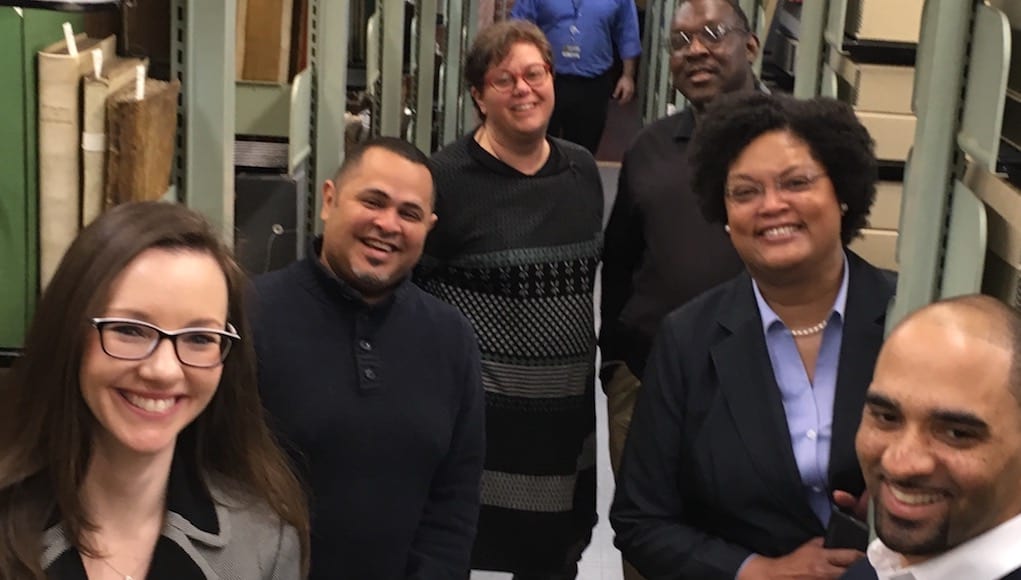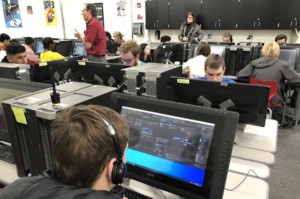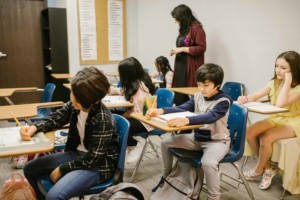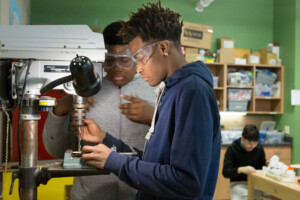HigherEd Approaches to Empowering Students

By Jeffrey Partridge
Colleges and universities are eager to offer students off-campus internships and service learning opportunities, but the implementation of place-based pedagogy is often left to individual educators. Unless a college makes a concerted effort to extend these opportunities, learning that is contextualized in the local community or environment is available to only a small percentage of students.

Institutions that make place-based education central to their identity do so by systematically supporting teaching methods that incorporate local resources and community organizations into coursework, thereby offering the majority of the students in their college an experience of learning within the context of communities. This approach benefits students, colleges and the communities in which they are situated. Some of these place-based colleges and the benefits they have discovered are explored below.
Teaching Students To Be Scholars at Guttman Community College
Guttman Community College, the newest City University of New York (CUNY) campus in midtown Manhattan, requires all students to take two semesters of City Seminar, a multi-disciplinary course that launches students into the communities of New York City to conduct inquiry-based research and place-based writing assignments. Laura Gambino, associate dean for assessment and technology, says that this experience “teaches students that they are researchers and scholars” and thereby “cultivates the mindset of being a college student.”
This place-based pedagogy runs throughout Guttman’s curriculum. The place-based approach begins in the “summer bridge” program that sends students to neighborhoods to look at communities through the lenses of history, sociology, architecture, statistics and culture. The college reinforces a focus on place through required courses like City Seminar, Arts in New York City, Introduction to Biology: Life in New York City, as well as the all-college community service days.
In a visit to Guttman, I observed students discussing an article on food justice for a writing class and preparing to go out on a “food truck” assignment. The instructor, Professor Claire King, explains that she and her colleagues introduce the city to students as another “text”—one that can be explored, interpreted and critiqued—that is, “read”—like a printed text. The students I spoke with were enthusiastic about their education at Guttman, citing the relevance of the learning experiences in the city as a prime motivating factor.
The City Becomes the Classroom at Temple University
Temple University is an example of a four-year institution fully embracing place-based pedagogy. Philadelphia Experience, or PEX, brings the city into general education courses, so that local schools, neighborhoods, markets, museums and concert halls become an extension of the regular classroom.
Terry Halbert, a business professor who was instrumental in developing PEX in 2008, told me that three factors led to a place-based approach:
- Many professors were already using the city in their courses and their research;
- The cultural and nonprofit communities surrounding the campus wanted access to the young, vibrant students at Temple; and
- Surveys showed that a growing percentage of new students chose Temple for its urban location.
Temple’s strategy was to capitalize on these factors by connecting the city to the general education curriculum. Today, Temple offers more than 40 courses on such topics as Education in the Global City, an urban education course that asks how global changes “impact cities like Philadelphia and the people who live here;” Philadelphia Dance Experience, a dance course that engages students with practicing artists and live performances in Philadelphia; and Guerilla Altruism, an architecture course focused on problems such as homelessness and sanitation that culminates in student projects to assist the communities around Temple University.
Deborah Block, the liaison between the arts community and Temple faculty, says that PEX faculty and students are enthusiastic about the learning experiences the place-based approach offers. But there is another winner, too. “The cultural community absolutely wants access to these students,” she says. It’s an opportunity to introduce students to the arts and “turn them into lifelong cultural patrons.” In this way, Block explains, “we create a bridge between the university and the community.”

Leveraging Community Arts Assets at Capital Community College
This bridge to the cultural community is significant. At Capital Community College (CCC) in Hartford, Connecticut, we created the Hartford Heritage Project in 2011 with the help of the National Endowment for the Humanities, which supported a two-year intensive study of Hartford cultural assets by fourteen faculty members. By holding workshops on site at the Hartford History Center, the Wadsworth Atheneum, the Harriet Beecher Stowe Center, the Mark Twain House, the Old State House and other institutions, we established relationships with the cultural community surrounding our college.
Since that initial grant-supported effort, the cultural community has continued to lay down the welcome mat for our college as the Hartford Heritage Project has gained traction throughout our college and in the city of Hartford. We developed low-cost institutional memberships for CCC students, staff and faculty and we continue to organize workshops to introduce our entire faculty to place-based teaching strategies and opportunities at various venues.
The result is a classic win-win situation—for the college and for the cultural community.
For example, we teamed up with the Hartford Stage to create One Play, which includes dramatically reduced ticket prices, faculty workshops, lectures and panels, discussions with actors, and curricular tie-ins for a selected play each semester. Mike Stotts, the Tony award-winning theater’s managing director, says “Hartford Stage has a need to diversify its audience and to introduce new, young people to the theater who may potentially attend on a regular basis. Each year, the collaboration brings 900 Capital students to Hartford Stage, which is a significant number of people who we hope develop a lasting taste for attending live theater.”
Similarly, our relationship with TheaterWorks has created innumerable opportunities for our college. Students can purchase two tickets for any show at just $5 apiece; professors who use a TheaterWorks play in their curriculum can bring their class to the play at no charge; and the theater has twice given CCC its house for performances of plays to raise funds for the Hartford Heritage Project.
What does TheaterWorks get out of the relationship? The answer is simple: they get the opportunity to introduce a young, diverse audience to their theater. “TheaterWorks understands that building audience is paramount to the theater’s future well-being,” explains Freddie McInerney, director of marketing and communications. “Cultivating a younger demographic ensures that our audience will grow with us.”
Trying Place-Based Education With Your College Students
Despite making educational and institutional sense, place-based pedagogy is still underutilized in mainstream higher education. This is partly due to the typical “lone-wolf nature” of higher education instruction. Individual faculty members spend an enormous amount of time mastering and keeping abreast of developments in their areas of specialization and creating a curriculum to convey their subject to students. Inviting faculty to add place-based methods to their teaching can feel like asking them to do additional work.
For example, faculty teaching a place-based course need to cultivate relationships with local museums and community organizations, arrange visits and logistics, invite speakers, realign lessons and make sure every student knows where to go and when.
This is precisely where an umbrella program or campus center can help. At CCC, we are working to minimize the hassles faculty face in implementing place-based pedagogy by providing resources and removing barriers. As director of the Hartford Heritage Project, it is my job to make and maintain relationships with organizations in the community and to organize workshops. The college has shown its support by funding institutional memberships, which give students free access to museums and allow faculty who teach at night to assign museum visits to students as homework.

Providing regular faculty development is essential. This is how faculty and staff in local organizations get to know one another, and how faculty form partnerships for interdisciplinary teaching and gain ideas for implementing place-based pedagogy.
Workshops also improve place-based education efforts. Temple University’s Terry Halbert says, “The challenge is to take it one step further. Not just: ‘There is a wonderful play. There is a wonderful painting. There is a wonderful building.’” The goal, she says, is to assist the community, to find out community needs and meet them, and to “engage students in the city as activists.”
Using Place-Based Opportunities For Critical Pedagogy
This deep approach that Halbert suggests is crucial because place-based pedagogy is particularly susceptible to a “halo effect.” Inspiring stories about students attending plays and going to museums can conceal a surface engagement with place. It is easy to mistake our students’ deep enthusiasm for deep learning.
Our understanding of the “place” in “place-based education” is an important factor in allowing deep learning to occur. Jan Nespor, an education policy professor at The Ohio State University, warns against treating “place” as a foil to “global” and imbuing it with special, almost mythic, qualities. Rather, “places are ongoing accomplishments produced through transactions and relations that cross their borders” and extend to the global.
Likewise, he argues that “communities” should not be shorthand for a Norman Rockwell idyll, but should be approached as fields of contestation where, as David Gruenewald recommends, the instructor guides students to “decolonize” and “reinhabit” spaces that are circumscribed by political, commercial and social forces emboldened by entrenched ideologies such as racism, sexism and classism.
Moreover, in our desire to offer students a sense of place, we should not lose sight of the fact that they come to us with a sense of place. Our job is not to fill empty vessels but to engage complex individuals, to lead them to critically examine and discover. This puts faculty in the position of co-learner, for we cannot know our students’ sense of place but must learn from them as they learn from us—as together we learn from the places and communities around us.

Busting Myths About Place-Based Approaches
Done well, place-based pedagogy can be transformative, but faculty who have not tried place-based approaches may feel reticent. They can’t take time for field trips or guest speakers when there is so much content to cover. Or they believe a local focus may make their subject too parochial or that local resources don’t speak to their subject.
These objections may be well-founded. Place-based pedagogy may not be for everyone. Yet, those who try it usually find the results are worth the effort. My colleague, Femi Bogle-Assegai, talks about her long-standing concern regarding “the apparent disconnectedness of the various neighborhoods and peoples within the city.” After adopting place-based approaches in her philosophy classes, she came to understand that these disconnections existed among her students partly because many of them lacked a contextualized understanding of the city and its history.
She states, “I am convinced that the Hartford Heritage Project—using the heritage of the city as its foundation and the city itself as the college campus—can produce a new generation of enlightened and connected citizens of Hartford… This is possible.” Like many college professors who have adopted place-based methods, Femi attests that students are empowered when they discover the power of place.
This blog is part of our “Place-Based Education” blog series. To learn more and contribute a guest post for the series, check out the PBE campaign page. Join in the conversation on social media using #PlaceBasedEd. For more on Place-Based Education see:
- Out of The Classroom, Off the Campus and Into the Community
- The Past, Present and Future of Place-Based Learning
- Putting the City at the Heart Of Place-Based Education
Jeffrey Partridge is director of the Hartford Heritage Project at Capital Community College in Hartford, Connecticut. The Hartford Heritage Project and Capital’s place-based education efforts were recently featured in a podcast. JeffreyPartridge, director of the Hartford Heritage Project and Humanities Chair at Capital, was interviewed on Teaching Matters, a podcast hosted by Scott Titsworth, Dean of Scripps College of Communication at Ohio University, and produced by WOUB public radio in Athens, Ohio.
Stay in-the-know with all things EdTech and innovations in learning by signing up to receive the weekly Smart Update.






0 Comments
Leave a Comment
Your email address will not be published. All fields are required.